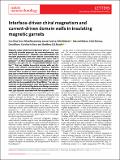Interface-driven chiral magnetism and current-driven domain walls in insulating magnetic garnets
Author(s)
Avci, Can Onur; Rosenberg, Ethan; Caretta, Lucas; Büttner, Felix; Mann, Maxwell; Marcus, Colin; Bono, David; Ross, Caroline A; Beach, Geoffrey SD; ... Show more Show less
DownloadAccepted version (2.882Mb)
Terms of use
Metadata
Show full item recordAbstract
© 2019, The Author(s), under exclusive licence to Springer Nature Limited. Magnetic oxides exhibit rich fundamental physics1–4 and technologically desirable properties for spin-based memory, logic and signal transmission5–7. Recently, spin–orbit-induced spin transport phenomena have been realized in insulating magnetic oxides by using proximate heavy metal layers such as platinum8–10. In their metallic ferromagnet counterparts, such interfaces also give rise to a Dzyaloshinskii–Moriya interaction11–13 that can stabilize homochiral domain walls and skyrmions with efficient current-driven dynamics. However, chiral magnetism in centrosymmetric oxides has not yet been observed. Here we discover chiral magnetism that allows for pure spin-current-driven domain wall motion in the most ubiquitous class of magnetic oxides, ferrimagnetic iron garnets. We show that epitaxial rare-earth iron garnet films with perpendicular magnetic anisotropy exhibit homochiral Néel domain walls that can be propelled faster than 800 m s−1 by spin current from an adjacent platinum layer. We find that, despite the relatively small interfacial Dzyaloshinskii–Moriya interaction, very high velocities can be attained due to the antiferromagnetic spin dynamics associated with ferrimagnetic order.
Date issued
2019Department
Massachusetts Institute of Technology. Department of Materials Science and EngineeringJournal
Nature Nanotechnology
Publisher
Springer Science and Business Media LLC